Scenic Hikes & Treks In Meghalaya
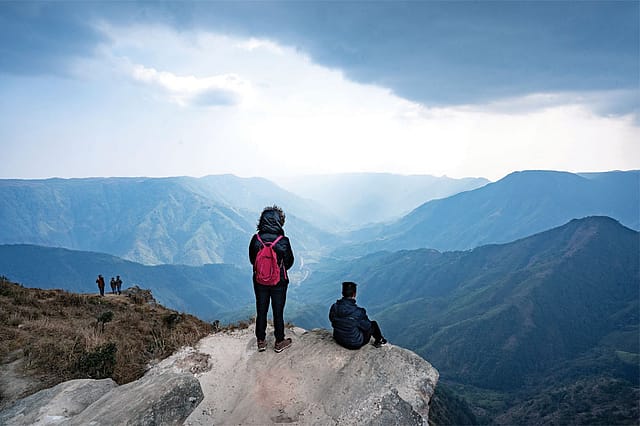
The scenic charms of Meghalaya, the 'Abode of Clouds', are second to none. The charming hill state in Northeast India is a natural paradise, replete with mountains and valleys, lush with verdure. Add to that the culture and hospitality of its people, who live close to nature and cherish it deeply, and you have a holistic experience.
One of the best ways to enjoy Meghalaya and its stunning natural beauty is to embark on a hike or a trek through it. From the tranquil paths through dense forests to the majestic views from the mountain peaks, every step in Meghalaya is a journey through time and terrain. As the trails wind through quaint villages, ancient sacred groves, and crystal-clear streams, one can't escape the sense of deep connection with nature.
Meghalaya has always attracted lovers of the great outdoors. The best part is the trails vary in difficulty, from easy to challenging, so you can easily pick one that suits your fitness level. The dry winter months are the best time to go trekking, since it can get quite wet in the rainy season here! These are some of the most charming and popular hiking trails in Meghalaya:
DAVID SCOTT TRAIL
The David Scott Trail is one of Meghalaya's most famous treks. It's part of a historical 100-km-long trail created by the 18th-century British officer David Scott, who was constructing a bridle path connecting the plains of Sylhet with the Khasi Hills. Today, the trail, winding through the East Khasi Hills, covers a distance of 16 kilometres and offers an adventure-filled journey through historical landscapes. Untouched by urbanization, through charming Khasi villages, ancient sacred groves, verdant meadows, sparse fields, undulating mountains, rushing streams, stone bridges, and natural pools. What makes this trek exceptional is its accessibility to individuals of all ages, with the flexibility to choose a shorter route.
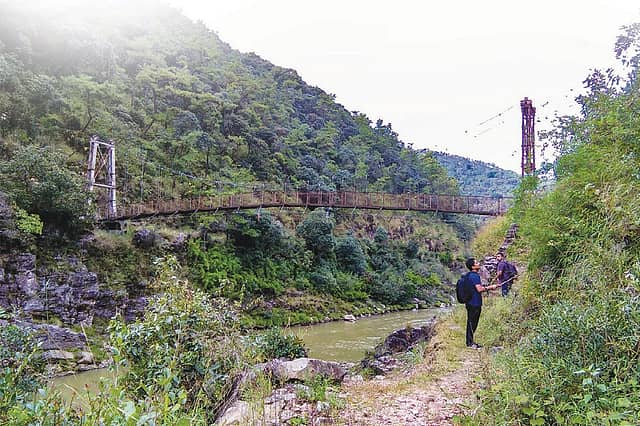
Connecting the renowned Khasi villages of Mawphlang and Lad Mawphlang, the early part of the trek has the Umiam River as a pleasant companion.As you progress, numerous smaller, gentle streams intersect the mountains. Upon entering the dense forests, the river disappears from view, replaced by the sight of multiple stone bridges spanning streams and rivers along the David Scott trek.The military-built Suspension Bridge over the Umiam River is an arresting sight. Some sections of the old trade route, covered in gravel, still exist in certain places. In the latter stretch of the trek, you will see monoliths from the Megalithic Period. These giant rock formations are sacred to the Khasis.
Sparse human settlements dot the hills along the route. In the absence of visible human presence, the David Scott trek unfolds a tranquil scene, where silent rivers flow and trees sway in the breeze, creating the perfect setting for a nature hike.
SHILLONG PEAK HIKE
The beauty of Meghalaya is that even close to the capital Shillong there are several nice hiking trails on offer. The Laitkor and Upper Shillong Reserve Forests unveil an array of picturesque trails weaving through a lush tapestry of thick pine and sub-tropical vegetation. Shillong Peak, the highest point in Meghalaya, offers a breathtaking vantage point with panoramic views of the surrounding hills and valleys. Standing at an elevation of 6,449 feet, it is a must-visit for awe-inspiring vistas and Traila glimpse of Shillong's natural grandeur. Though the ascent is steep in many sections, the allure of reaching the higher realms of the town through these verdant forest paths is an achievable feat in less than an hour.
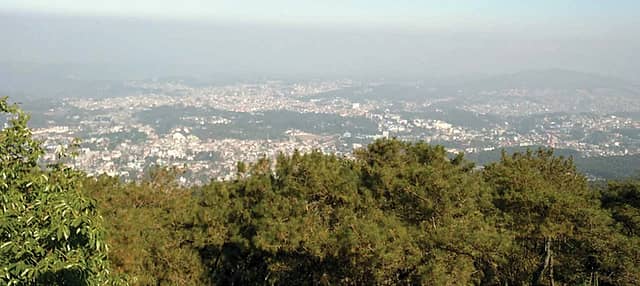
One of the well-frequented trails within these forests is the Rhododendron Trek route, renowned for its scenic beauty and vibrant flora. As hikers meander through this enchanting landscape, they are greeted by the graceful presence of rhododendron blossoms, adding a burst of colour.
For those seeking an alternative starting point, a trail originating from the Lawsohtun locality in southern Shillong provides a direct route to the coveted Shillong Peak viewpoint. This trail promises an immersive journey, taking trekkers through the heart of the forest, revealing hidden gems of flora and fauna along the way. The Shillong Peak viewpoint, perched at an elevation, rewards adventurers with breathtaking panoramic vistas.
TURA PEAK HIKE
The cultural and administrative centre of the Garo Hills, Tura is a gateway to popular destinations like Balpakram, Nokrek and Siju Cave. The trek to Tura Peak, nestled within Nokrek National Park, is a rejuvenating adventure. As you bid farewell to the bustling town, the trail leads through dense tropical foliage, offering a refreshing escape into nature. Opting for an early morning hike not only helps avoid the day's warmth but also enhances the likelihood of encountering rare bird species that inhabit these lush surroundings.
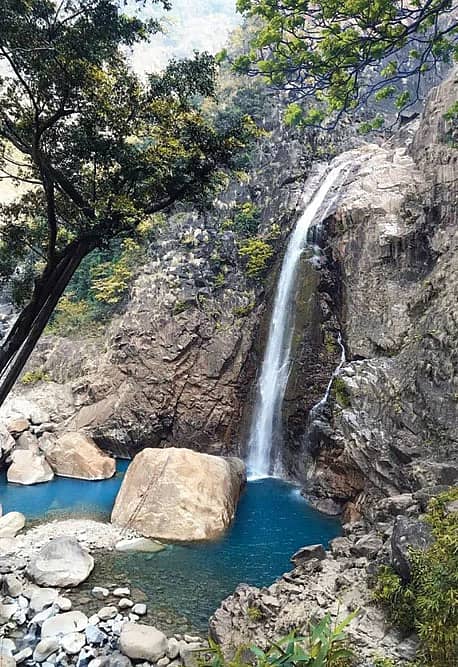
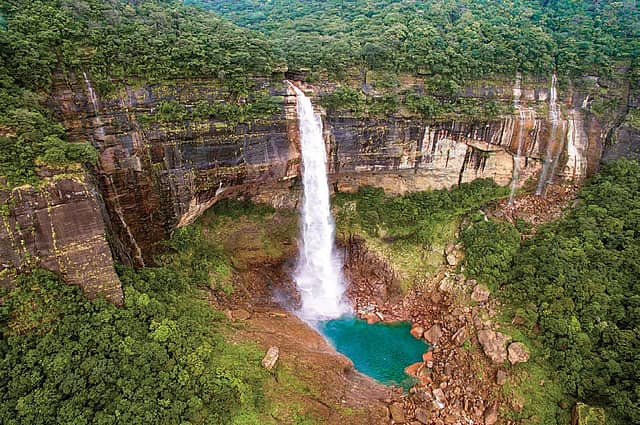
The forested, steep slopes are also the dwelling grounds of the Hoolock gibbons, known for their distinctive hoots. The trek, lasting no more than 5 hours round trip, is of moderate intensity. Tura Peak, standing as a silent sentinel, rewards trekkers with sweeping vistas from its summit. Post-monsoon and winter are the best time for the trek, although a monsoon excursion has the added allure of seasonal waterfalls cascading along the route.
KYLLANG ROCK TREK
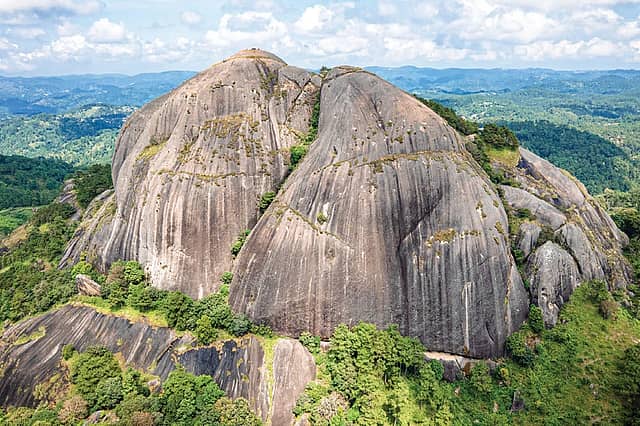
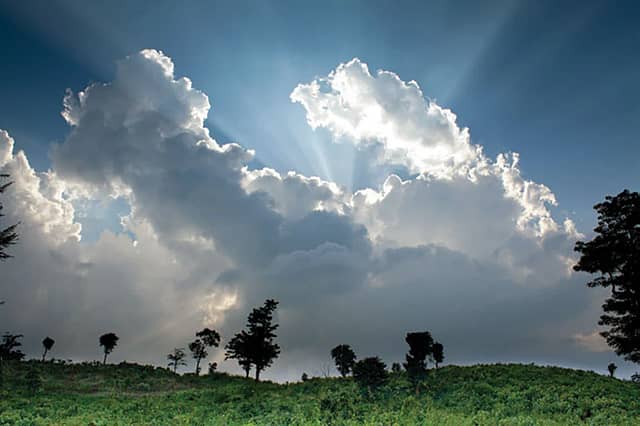

Kyllang Rock stands as a remarkable natural monolith, a colossal grey dome emerging from the pine forests of the West Khasi Hills. Ascending along a designated path, adorned with rest stops and summer houses, this is a breathtaking trek. The pinnacle offers a striking panorama, encompassing lush woods, charming villages, and captivating sunrises and sunsets for those strategic enough to time their hike accordingly. The presence of rare white rhododendrons scattered amidst depressions and bushes at the dome's base adds another layer of attraction. The area's natural diversity is further enhanced by old oaks and various indigenous flora. This is an intense but short trek.
LAITLUM CANYONS TRAIL
Nestled in the East Khasi Hills, the Laitlum Canyons are a hidden gem, an enchanting yet less-explored haven for tourists and trekkers situated a mere 21 kilometres south of Shillong. The trail offers breathtaking panoramic vistas, cradled by majestic hills and valleys, and makes for a secluded and serene escape. From the pinnacle of the Canyons, a mesmerizing view unfolds, showcasing Rasong, a quaint hamlet nestled within the folds of the Laitlum gorge. You can also trek to Smit and Rasong villages from here.
NONGRIAT DOUBLE-DECKER LIVING ROOT BRIDGE TREK
Embarking on the journey to the double-decker root bridge in Nongriat is nothing short of an epic experience. The adventure commences at the pinnacle of the valley near Tyrna village, where you descend approximately 3,000 steps. Along the way, you'll be treated to breathtaking vistas and natural wonders.
Meghalaya's root bridges hold a mystique, deeply rooted in the ancient Khasi lifestyle that once revolved around traversing dense forests and navigating swift rivers as part of daily life. Nongriat's double-decker root bridge stands out for its unique multi-level structure, a testament to the intricate botanical architecture that took years to evolve. Adjacent to the bridge, serene pools surrounded by rocks provide a perfect spot for relaxation, and well-maintained food stalls ensure you won't go hungry.
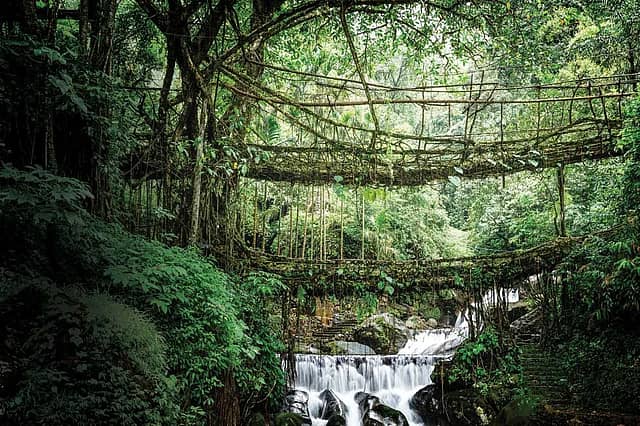
For those seeking more adventure, a brief yet exhilarating trek past the double-decker bridge leads to Rainbow Falls, renowned for its turquoise pool and colossal boulders. You will traverse tranquil betel nut plantations before entering a proper jungle trail—the captivating sight at the conclusion of this extended adventure makes it all worthwhile.
Reaching the Nongriat root bridges demands a certain level of fitness. Allocate an entire day for the round-trip trek, and opting to stay overnight in one of the numerous guest houses is advisable. This allows you to savour the picturesque surroundings and ascend at your own leisurely pace.
MAWRYNGKHANG TREK
Better known as the Bamboo Trek, the Mawryngkhang Trek is a true adventure, where for the most part you walk on bamboo bridges. Originating from Wahkhen village in the East Khasi Hills, the Bamboo trek is a showcase of indigenous craftsmanship, where the locals have skilfully constructed bamboo bridges, secured with cane ropes, providing a sturdy path. The trek requires approximately 3-5 hours to complete. Starting from the village, the trail descends to the base of a river valley. En route, adventurers traverse several precarious bamboo bridges over the rushing Wahrew River. Beyond the river crossing, there are other steep bridges and hidden waterfalls at every turn. The climax of the trek is a challenging climb up a ladder, culminating at the awe-inspiring 'U Mawryngkhang' stone, renowned as the king of stones. Trekkers are rewarded with breathtaking vistas of clouds, lush greenery, and waterfalls.
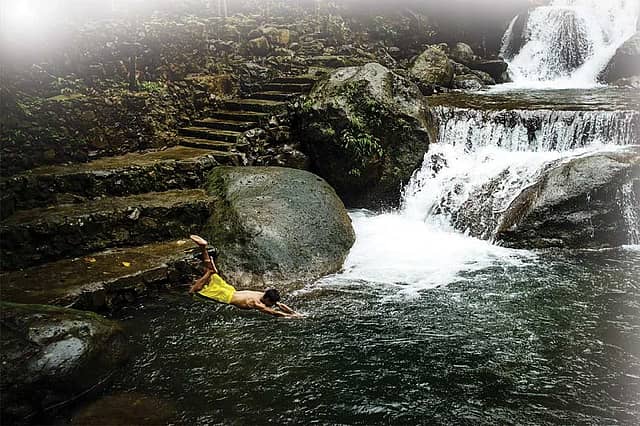
NOHKALIKAI FALLS WALK
Nohkalikai Falls near Sohra is one of the tallest plunge waterfalls in India, plunging dramatically from a height of approximately 340 metres. The hike to the head of the fall stakes you to a natural stone gate that hangs over the thundering cascades and the verdant gorges.
This trek is of moderate difficulty, with clear rock indications guiding you effortlessly to the summit. It is a short trek, however, requiring about 40 minutes from the entry point to the tip of the falls. It is not recommended for small children or individuals of advanced age with health concerns. However, setting aside such considerations, you are guaranteed to behold breathtaking panoramic views and experience the thrill of a lifetime.
Commencing the trek in the morning or afternoon hours is advisable, ensuring a return by 5 pm before darkness sets in. Adventurous souls often opt for this journey in the months when the water flow is at its peak, enhancing the already spectacular scenery.
MAWSYNRAM FOSSIL HIKE
Numerous villages near Mawsynram beckon tourists with a plethora of activities, while some gems remain pristine and hidden. One such is the village of Janiaw, which stands out for its abundance of fossil sites scattered along ravines, caves, and intricately embedded within walls and rocks. A vertical drop canyon, characterized by deep cracks formed through tectonic shifts, adds an intriguing dimension to the landscape. Venturing further, the Weikynmei area captivates visitors with one of the region's largest waterfalls, visible from Laitkynsew village. Upstream, a network of caves and natural pools awaits exploration through guided hikes led by local experts. Additionally, there are captivating rock formations, some of which create tunnels along the riverbed, providing a unique subterranean experience for those who venture into their depths.

Trekking in Meghalaya truly makes for an immersive and exciting experience. As the sun sets over the lush hills and vibrant landscapes of Meghalaya, one can't help but marvel at the enchanting tapestry that unfolds during a hiking and trekking adventure in this picturesque state. Meghalaya, with its scenic trails like the Laitlum Canyons and the historic David Scott Trek, beckons explorers to discover the perfect blend of nature's beauty and cultural richness.
So, lace up those hiking boots, embrace the untouched beauty, and let Meghalaya unveil its secrets, one step at a time. In every rustle of leaves and every panoramic vista, you'll find not just a hiking trail but a pathway to an enduring love affair with the captivating allure of Meghalaya's natural splendour.
(A marketing initiative by Open Avenues)